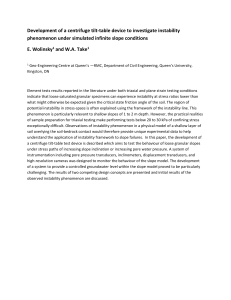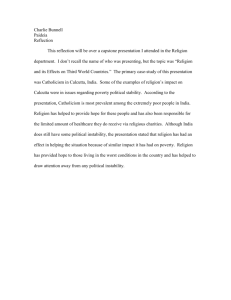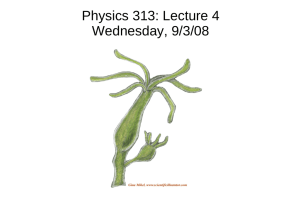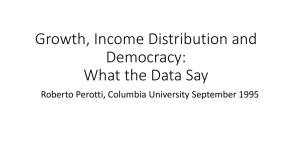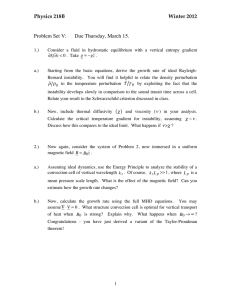Proceedings of 21st International Business Research Conference
advertisement
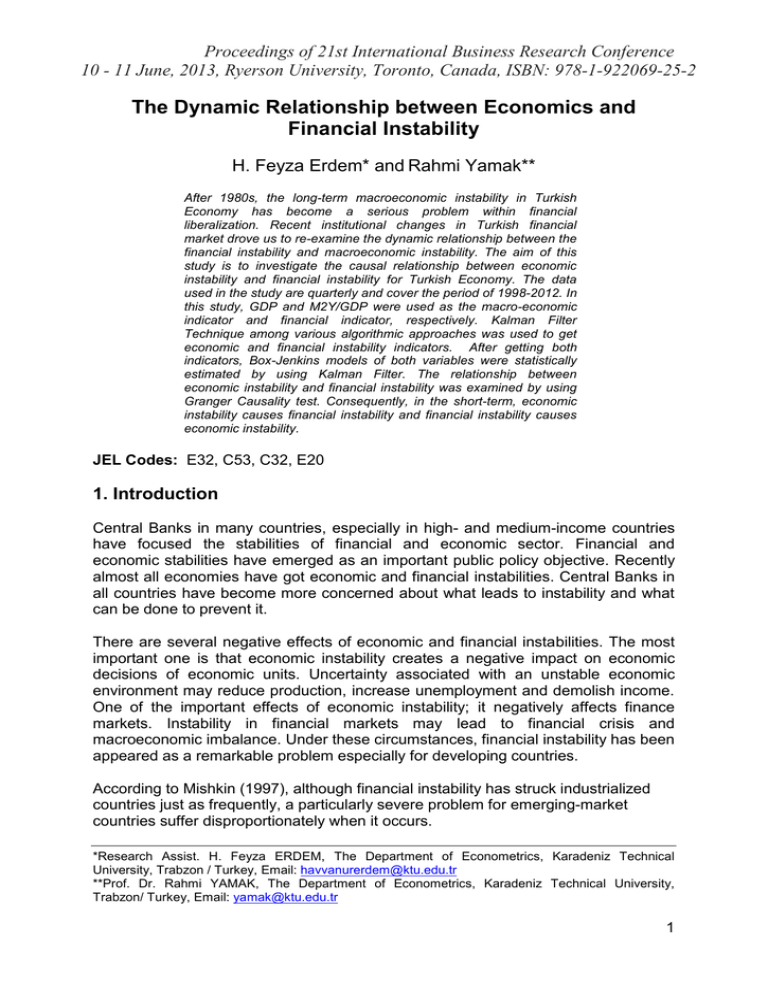
Proceedings of 21st International Business Research Conference 10 - 11 June, 2013, Ryerson University, Toronto, Canada, ISBN: 978-1-922069-25-2 The Dynamic Relationship between Economics and Financial Instability H. Feyza Erdem* and Rahmi Yamak** After 1980s, the long-term macroeconomic instability in Turkish Economy has become a serious problem within financial liberalization. Recent institutional changes in Turkish financial market drove us to re-examine the dynamic relationship between the financial instability and macroeconomic instability. The aim of this study is to investigate the causal relationship between economic instability and financial instability for Turkish Economy. The data used in the study are quarterly and cover the period of 1998-2012. In this study, GDP and M2Y/GDP were used as the macro-economic indicator and financial indicator, respectively. Kalman Filter Technique among various algorithmic approaches was used to get economic and financial instability indicators. After getting both indicators, Box-Jenkins models of both variables were statistically estimated by using Kalman Filter. The relationship between economic instability and financial instability was examined by using Granger Causality test. Consequently, in the short-term, economic instability causes financial instability and financial instability causes economic instability. JEL Codes: E32, C53, C32, E20 1. Introduction Central Banks in many countries, especially in high- and medium-income countries have focused the stabilities of financial and economic sector. Financial and economic stabilities have emerged as an important public policy objective. Recently almost all economies have got economic and financial instabilities. Central Banks in all countries have become more concerned about what leads to instability and what can be done to prevent it. There are several negative effects of economic and financial instabilities. The most important one is that economic instability creates a negative impact on economic decisions of economic units. Uncertainty associated with an unstable economic environment may reduce production, increase unemployment and demolish income. One of the important effects of economic instability; it negatively affects finance markets. Instability in financial markets may lead to financial crisis and macroeconomic imbalance. Under these circumstances, financial instability has been appeared as a remarkable problem especially for developing countries. According to Mishkin (1997), although financial instability has struck industrialized countries just as frequently, a particularly severe problem for emerging-market countries suffer disproportionately when it occurs. *Research Assist. H. Feyza ERDEM, The Department of Econometrics, Karadeniz Technical University, Trabzon / Turkey, Email: havvanurerdem@ktu.edu.tr **Prof. Dr. Rahmi YAMAK, The Department of Econometrics, Karadeniz Technical University, Trabzon/ Turkey, Email: yamak@ktu.edu.tr 1 Proceedings of 21st International Business Research Conference 10 - 11 June, 2013, Ryerson University, Toronto, Canada, ISBN: 978-1-922069-25-2 In the last three decades, Turkey has had many political, economic and financial instabilities. However, recently Turkish economy has experienced more stable economic and financial conditions. The events of the last years have posed challenges for policymakers and have motivated to re-examine the relationship between financial and economic instability in Turkish economy. This paper addresses two questions: Does economic instability cause financial instability, or does financial instability lead to economic instability? Within this framework, the purpose of this study is to investigate the causal relationship between economic instability and financial instability for Turkish Economy. The data used in the study are quarterly and cover the period of 19982012. Two important features arise from current study. First, we examine the possible dynamic relation between economic instability and financial instability. Second, our study differs from other studies by using Kalman Filter Technique to get economic and financial instability indicator. We use GDP and M2Y/GDP as the macro-economic indicator and financial indicator, respectively. The study is organized as follows: Firstly, the theoretical and empirical literature is discussed in terms of the relationship between economic instability and financial instability. Secondly, data is described and the methodology is given. Thirdly, the causal relationship between economic instability and financial instability is analyzed by presenting empirical findings. Finally, we summarize econometric findings. 2. Literature Review Economic and financial instability has been subject to many studies. In the related literature, there are two important questions: why and how economic instability may play a crucial role in the financial sector and why and how financial instability may affect the whole economy? There are several approaches to investigate the analysis of the dynamic behaviors of the economic and financial system. It is useful to begin by summarizing the basic intuition underlying the theory of economic and financial instability, and some of the more important results from the literature. One of the most important approaches has been the „Financial Instability Hypothesis‟ which was proposed by Hyman Minsky (1919 – 1996). „Financial Instability Hypothesis‟ mean that the financially-dominated capitalist economy has been inherently unstable (Minsky 1975, 1982, 1986). According to Minsky, two theorems of the financial stability hypothesis: (1) “the economy has financing regimes under which it is stable, and financing regimes in which it is unstable”, and (2) “over periods of prolonged prosperity, the economy transits from financial relations that make for a stable system to financial relations that make for an unstable system.” Minsky, based his theory on the inbuilt instability of financial markets on Keynes‟ theory of money, in which the key role was played by the explanation about the speculative demand for money. Following Keynes‟ teaching, he was an advocate of state intervention on financial markets, sharply opposing the deregulatory measures that were applied to these markets during the 1980s in the US. (Jovancai, 2010). 2 Proceedings of 21st International Business Research Conference 10 - 11 June, 2013, Ryerson University, Toronto, Canada, ISBN: 978-1-922069-25-2 Minsky‟s theory has been investigated on instability of financial markets among economists. For example, Kindleberger (1989) was studied about financial instability, based Minsky hypothesis. He explained “market euphoria”. According to Kindleberger, financial instability had five steps: displacement, boom, overinvestment, revulsion and tranquility. Friedman (1982), the interventions in the supply of money and credit channels can cause economic instability. In other words, the central poor management of banks, the money supply increases or the extreme narrowing policies, can lead to the disruption of financial markets and crises. Bockelmann and Borio (1990) investigated financial instability and real economy. The paper deal with three different areas of the financial sphere: national moneys, exchange rates and financial claims, markets and institutions. Pindyck and Solimano (1990) examined economic instability and aggregate investment. They explored the empirical relevance of irreversibility and uncertainty for aggregate investment behavior. Mishkin (1999) examined what causes and propagates financial instability. Mishkin used to understand the structure of the financial system and he suggested that there were four categories of factors that lead to financial instability: increases in interest rates, increases in uncertainty, asset market effects on balance sheets, and problems in the banking sector. Martin and Rogers (2000) examined long-term growth and short-term economic instability. Brousseau and Detken (2001) presented an example of a possible conflict between short-term price stability and financial stability. Allen (2005) studied modeling financial instability. Lima and Meirelles (2006), the financial fragility of the economy explained on the modeled Minsky. Jeanneney and Kpodar (2011) investigated financial instability which accompanied financial development was detrimental to the poor and dampened the positive effect of financial development on the reduction of poverty. 3. Data and Methodology The data used in this study were quarterly and cover the period from 1998:012012:01 for Turkey. Real Gross Domestic Product (GDP) and ratio of broad money supply to GDP (M2Y/GDP) are used as the macro-economic indicator and financial indicator, respectively. The both variables are obtained from Electronic Data Delivery System, the Central Bank of the Republic of Turkey (TCMB_EVDS). The both variables are adjusted seasonality1 and are used to be logarithm. The econometric process used is followed in this way: first of all, as an empirical enquiry, we deal unit root tests procedures to determine whether GDP and M2Y/GDP variables are indeed stationary. We use two different unit root tests to determine whether the GDP and M2Y/GDP series are stationary: developed by Dickey and Fuller (1979) (Augmented Dickey-Fuller (ADF))2 and by Phillips and Perron (1988) (PP)3. After then, getting both indicators, Box-Jenkins models of both variables are statistically estimated by Kalman Filter Technique. Since Kalman Filter Technique enables time varying error term variations to be obtained, the time varying error term variation is used as a criterion for instability series. Finally, the probable 1 2 3 We used Moving-Average Methods to adjust seasonallity. For more information: Winters (1960). For more information: Dickey, D. and Fuller, W. (1979, 427-431). For more information: Phillips, P. and Perron, P. (1998, 335-346). 3 Proceedings of 21st International Business Research Conference 10 - 11 June, 2013, Ryerson University, Toronto, Canada, ISBN: 978-1-922069-25-2 relationships between the economic and financial instability series are examined by using time series techniques. In the Kalman Filter estimation technique, the first necessary step is to construct the state space form, which consists of measurement and transition equations (Kalman, 1960). Measurement equation is not different of standard OLS regression equation‟s coefficient which is added time factor. The following equation (1) is measurement equation. t + t t t + t E( t )=0 and V( t )= Vt (1) The transition equation is the system of equation how changing parameters of measurement equation change depending over time. In this studying, it was assumed that variable parameters of measurement equation has AR(1) structure. According to (1) number equations, there are two transition equations. t t t1 t2 t-1 t-1 + + (2) (3) 1t 2t To explain Kalman Filter process, it must be expressed (1), (2), (3) equations by matrix form. (4) and (5) equations are matrix form of (1), (2) and (3) equations. yt xt t + t t-1 + t (4) (5) t (4) equation is expression as matrix of (1) measurement equation. While y represents Y, x does X (including the constant term). The software in the form of the transition equation is (5) equation. Z represent the vector of size 2x1 that has elements and , represent main diagonal. t1, t2 represent the matrix of size 2x2 which is zero off-main diagonal and t , describe the vector of size 2x1 that has elements 1 , 2 . In the first step, by using the initial or unconditional estimates of Z and their variancecovariance matrix P, the conditional estimates of Z and their conditional variancecovariance matrix are obtained from the following equations (6) and (7). Zt|t-1 = Pt|t-1 = (7) (6) t-1 t-1 + In the second step, the conditional y, the one step ahead prediction error H, and its conditional variance F, are estimated by using outputs of the first step and the following equations (8) - (10). 4 Proceedings of 21st International Business Research Conference 10 - 11 June, 2013, Ryerson University, Toronto, Canada, ISBN: 978-1-922069-25-2 yt|t-1 = xt Zt|t-1 Ht = yt - yt|t-1 Ft = xt Pt|t-1xt ' + V (8) (9) (10) In the final step, the unconditional Z and its variance-covariance matrix P, are obtained by utilizing the outputs of the previous steps and the following updating equations (11) and (12). ' t =Pt|t-1–(Pt|t-1xt Ft -1 xt Pt|t-1) (11) ' -1 t = Zt|t-1 + Pt|t-1xt Ft Ht (12) Once the filter completes all three steps and provides unconditional P and Z, then the unconditional estimates enter into step 1, as being inputs and the filter again starts to work to complete all three steps for t+1 and continues until last time period, t-1. Therefore, the Kalman Filter is known to be a recursive estimation technique through time. 4. Empirical Findings Before we estimate the system that establishes the relationship between economic and financial instabilities, we summarize results of unit root tests (ADF and PP) for the level and first difference of both variables in Tables 1 and 2. Table 1: Unit Root Test Results for GDP Exogenous ADF PP GDP ΔGDP GDP ΔGDP Intercept -0.1645 -7.5307 *** 0.4552 -8.8726 *** Trend and Intercept -2.7482 -7.6094*** -2.6812 -10.5620 *** None 2.0102 -6.5923 *** 3.5104 -6.5600 *** Note:*** %1 level test critical values. Δ: first difference of the variable. Exogenous Table 2: Unit Root Test Results for M2Y/ GDP ADF PP Intercept Trend and Intercept None M2Y/ GDP Δ (M2Y/ GDP) M2Y/ GDP -2.6154* -2.5466 0.4450 -5.4621*** -5.5887*** -5.2200*** -2.5047 -2.4923 0.1086 Δ (M2Y/ GDP) -5.4705*** -5.6002*** -5.2115*** Note:*** %1 level, **%5 level, *%10 level test critical values. Δ: first difference of the variable. The null hypothesis for ADF and PP tests indicate the existence of a unit root. According to the unit root test results, GDP and M2Y/GDP is stationary in the first difference. So, ADF and PP tests reject the null hypothesis of a unit root in the series at the 0.01 level, indicating that the both series are stationary in the first differences. In order to obtain instabilities of economic and financial series, first differences of the both series are used. 5 Proceedings of 21st International Business Research Conference 10 - 11 June, 2013, Ryerson University, Toronto, Canada, ISBN: 978-1-922069-25-2 Before we get series of economic and financial instability under the Kalman Filter techniques, firstly, we must determine the best ARIMA4 model for GDP and M2Y/GDP. We decided the best model as ARIMA(2,1,2) and ARIMA(2,1,1) for GDP and M2Y/GDP series, respectively. In Tables 3 and 4, the results of the best ARIMA models are given for both series. Table 3: ARIMA(2,1,2) Model for GDP Coefficient Std. Error t-Statistic C 0.0106 AR(1) -0.0758 AR(2) -0.9164 MA(1) 0.2898 MA(2) 0.9604 2 R 0.40 Inverted AR Roots -.04-.96i Inverted MA Roots-.14+.97i 0.0047 0.0396 0.0438 0.0281 0.0285 2.2356 -1.9145 -20.8842 10.3126 33.61215 Prob. 0.0300 0.0614 0.0000 0.0000 0.0000 -.04+.96i -.14-.97i Note: In order to find out whether the residuals are serially correlated, Breush-Godfrey Serial Correlation Lagrange Multiplier (LM) test were used for first and fourth order serial correlation. LM1: 0.38 and LM4: 0.93. There were no correlated. Table 4: ARIMA(2,1,1) Model for M2Y/ GDP Coefficient Std. Error t-Statistic C AR(1) AR(2) MA(2) 0.0081 1.1260 -0.3086 -0.9591 R2 Inverted AR Roots Inverted MA Roots 0.0025 0.1388 0.1300 0.0513 0.21 .65 .96 3.2085 8.1090 -2.3727 -18.6786 Prob. 0.0023 0.0000 0.0215 0.0000 .47 Note: For first and fourth order serial correlation, Breush-Godfrey test‟s results: LM1: 0.94 and LM4: 0.74. There were no correlated. 2 As seen in Tables 3 and 4, R statistics of ARIMA models are 0.40 and 0.21, respectively. AR Roots <|1| and MA Roots < |1| for both models. These mean that estimated AR processes are stationary and estimated MA processes are invertible. In addition, the estimated coefficients are statistically significant at %10 level for both models. After Box-Jenkins models are estimated for both variables, the Kalman Filter Techniques is run and economic and financial instabilities are derived. In Figures 1 and 2, economic and financial instabilities graphics are shown. 4 We computed the correlograms of GDP and M2Y/GDP series to define which ARIMA model was best. We run various ARIMA models with different orders: ARIMA(1,1,1), ARIMA(1,1,2), ARIMA(1,1,3), ARIMA(2,1,1), ARIMA(2,1,2), ARIMA(2,1,3), ARIMA(3,1,1), ARIMA(3,1,2), ARIMA(3,1,3). For more information about ARMA models: Box, G.E.P. and G.M.Jenkins (1976, 575). 6 Proceedings of 21st International Business Research Conference 10 - 11 June, 2013, Ryerson University, Toronto, Canada, ISBN: 978-1-922069-25-2 Figure 1. Economic Instability Figure 2. Financial Instability Figure 1 reveals that economic instability takes on its highest value at the fourth period of 1998 and on its lowest value at the first period of 2010. Figure 2 shows that the lowest value of financial instability exists at the second period of 2009 and the highest value exists at the fourth period of 2001. Especially, the high values of economic and financial instabilities are accompanied at the crisis periods: 1998, 2000, 2001, 2008, 2010, 2011. As a final step, we investigate the relationship between economic and financial instability variables. For this purpose, Granger causality5 test is conducted, which essentially test whether there is a consistent lead and lag relationship between the both variables. The Granger causality between the two variables, economic instability and financial instability, asks that how much of the current economic instability can be explained by a regression on its past values, and then tries to test whether inclusion of the lagged values of financial instability into the regression to explain economic instability have statistical significance as a whole. Table 5 presents the Granger causal relation between economic and financial instabilities. Table 5: Granger Causality Results Equations EcoInst.(p) FinInst (p) LM(1) R2 FTEST(Wald) (1)EcoInst.→FinInst. 4 8 0.3916 [0.5325] 4. 8162 [0.0.005] EcoInst causes FinInst. 0.57 (2)FinInst.→EcoInst. 8 4 0.0039 [0.9505] FinInst causes EcoInst. 0.54 3.2245 [0.0236] Result Note: p is optimal lag for AIC. For fourth order serial correlation, Breush-Godfrey test were tested for the equations. According to these results, there is no fourth-order correlation. [ ] expresses probability values. First Equation: LM4 : 0.2454 [0.9102], Second Equation: LM4 : 0.2542 [0.9042]. . EcoInst. is economic instability variable and FinInst. is financial instability variable The null hypothesis in Equation (1) is that the lags of economic instability is not significant as a whole, that is to say, economic instability does not Granger cause 5 For more information of Granger Causality: Granger, C. W. J. (1969, 424-438). Unit-root tests(Augmented Dickey-Fuller and Phillips-Perron) of the instability series are tested. According to unit root test results, both instability series are stationary in the level. 7 Proceedings of 21st International Business Research Conference 10 - 11 June, 2013, Ryerson University, Toronto, Canada, ISBN: 978-1-922069-25-2 financial instability. Likewise, the null hypothesis in Equation (2) is that the lags of financial instability have no statistical significance in explaining economic instability which also means that financial instability does not Granger-cause economic instability. By employing F-type Wald tests, the results of pairwise Granger causality analysis which are applied on the joint significance of the sum of lags of each explanatory variable are reported below. For this purpose, various lag lengths are considered to see whether the estimation results are sensitive to the a priori lag selection. The results of F-type Wald tests indicate significance at the 0.05 and 0.10 levels for both equations. So, we can easily notice that the null hypotheses are rejected at the 0.05 and 0.10 significance level for both equations. In other words, we find that economic instability causes financial instability and financial instability cause economic instability. There are two-sided relation between economic instability and financial instability in Turkish economy in short-term. 5. Conclusions Stability of a country has been widely evaluated in a multi-dimensional perspective and in a long-term process. In this process, national and international results of a country‟s stability level are usually interpreted as an indicator of the performance in national and international arena. For all developing and developed economies, macroeconomic stability is not independent from financial stability. Nowadays, almost all economies have stability problems in the financial markets where there are predictable and unpredictable changes within globalization. There are several negative effects of instability in financial markets, such as reduction of production, increase of unemployment, demolish of income and resources distribution, financial crisis, macroeconomic imbalance. After 1980s, the long-term macroeconomic instability in Turkish Economy has become a serious problem within financial liberalization. In this study, the causal relationship between economic instability and financial instability were examined for Turkish Economy. The data used in the study are quarterly and cover the period of 1998-2012. Due to the fact that instability series was not directly observable, economic instability and financial instability variables were obtained by using Kalman Filter technique. Economic and financial indicators were described, as GDP and M2Y/GDP, respectively. After getting both indicators, Box-Jenkins models of both variables were statistically estimated by Kalman Filter technique. Then, the economic and financial instability were obtained by Kalman Filter technique. After getting both instability series, a probable the relations between economic and financial instabilities variables were analyzed by using Granger Causality. As a result, in the short-term, economic instability causes financial instability and financial instability causes economic instability. So, the causal relationship between economic instability and financial instability were get as twosided. References Allen, F. 2005. “Modeling financial instability, National Institute Economic 192, pp. 57-67. eview”, 8 Proceedings of 21st International Business Research Conference 10 - 11 June, 2013, Ryerson University, Toronto, Canada, ISBN: 978-1-922069-25-2 Bockelmana, H. and Et Borio, C. 1990. “Financial instability and the real economy, De Economist”, Vol.138, N4, pp. 428-450. Box, G.E.P. and Jenkins, G.M. 1976. “Time series analysis: forecasting and control. holden-day”, San Francisco, 575. Brousseau, V. and Brousseau, V., Detken, C. 2001. “Monetary policy and fears of financial instability, European Central Bank”, Working Paper. Dickey, D. and Fuller, W. 1979. “Distribution of the estimators for autoregressive time series with a unit root, Journal of the American Statistical Association”, 74, ss.427-431. Friedman, M. Schwartz, A. J. 1982. “The role of money, National Bureau of Economic esearch”, 0-226-26409-2, 621 – 632. Granger, C. W. J. 1969. “Investigating causal relations by econometric models and cross spectral methods, Econometrica”, 37, 424–438. Jeanneney S. G. and Kpodar, K. 2011. “Financial development and poverty reduction: can there be a benefit without a cost?, The Journal of Development Studies”, 47. Jovancai A., M.A. 2010. “Instability of financial markets as a cause of the global financial crisis the minsky moment, Scientific Review Paper”, Vol. 7 (1) 2010: pp. 17-28 Kalman, R. E. 1960. “A new approach to linear filtering and prediction problems, Journal of Basic Engineering”, 82:34-45. Kindleberger, C., 1989. “Manias, panics, and crashes: a history of financial crises, New York: Basic Books”, Inc. Lima, G.T. and Meirelles, A.J.A. 2006. “Debt, financial fragility, and economic growth: a post keynesian macromodel, Journal of Post Keynesian Economics”, 29: 93-115. Martina, P. and Rogers, C.A. 2000. “Long-term growth and short-term economic instability, European Economic Review”, Volume 44, Issue 2, 359–381. Mishkin, F.S. 1997. “The causes and propagation of financial instability: lessons for policymakers, In Federal Reserve Bank of Kansas City, Maintaining Financial Stability in a Global Economy”. Minsky, H. P. 1975. “John Maynard Keynes and New York: Columbia University Press”. Minsky, H. P. 1982. “Can "it" happen again?, Essays on Instability and Finance. Armonk and N.Y.: M.E. Sharpe”. Mishkin, F.S. 1999. “Global financial instability:framework, events, issues, Journal of Economic Perspectives”. Minsky, H.P. 1986. “Stabilizing an unstable economy, New Haven, Conn.:Yale University Press”. Phillips, P. ve Peron, P. 1988. “Testing for a unit root in time series regressions, Biometrika”. 75(2). ss.335-346. Pindyck, R. S. and Salimano, A. 1993. “Economic instability and Aggregate investment, National Bureau of Economic Research”, 8, 259-318. Winters, P. R. 1960. “Forecasting sales by exponentially weighted moving averages, Management Science”, 6, 324-342. 9

![[These nine clues] are noteworthy not so much because they foretell](http://s3.studylib.net/store/data/007474937_1-e53aa8c533cc905a5dc2eeb5aef2d7bb-300x300.png)
